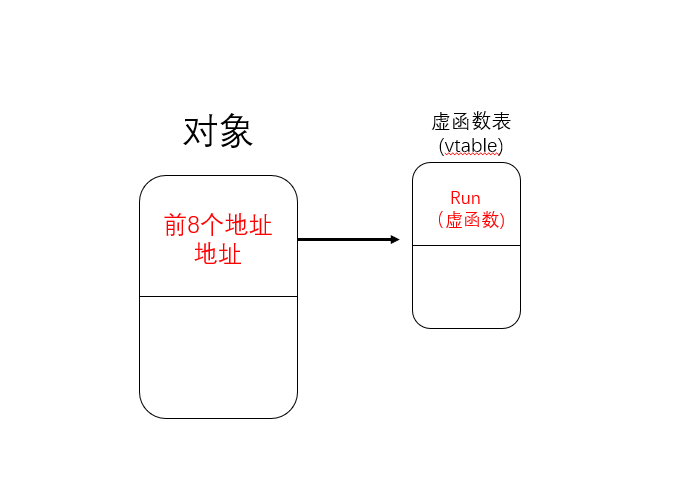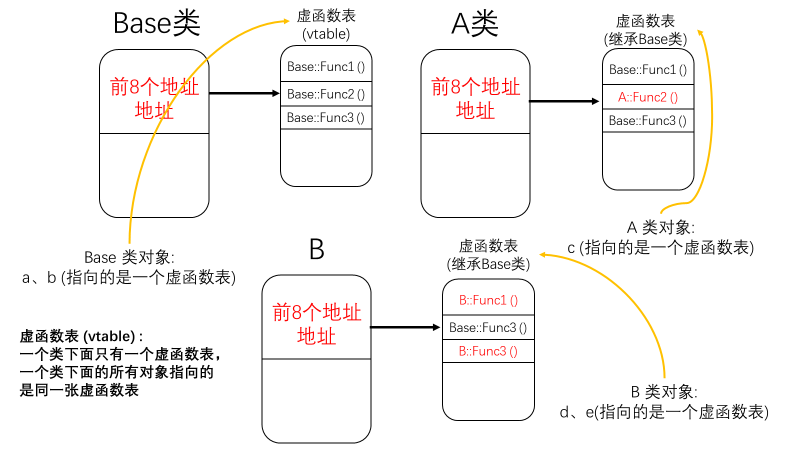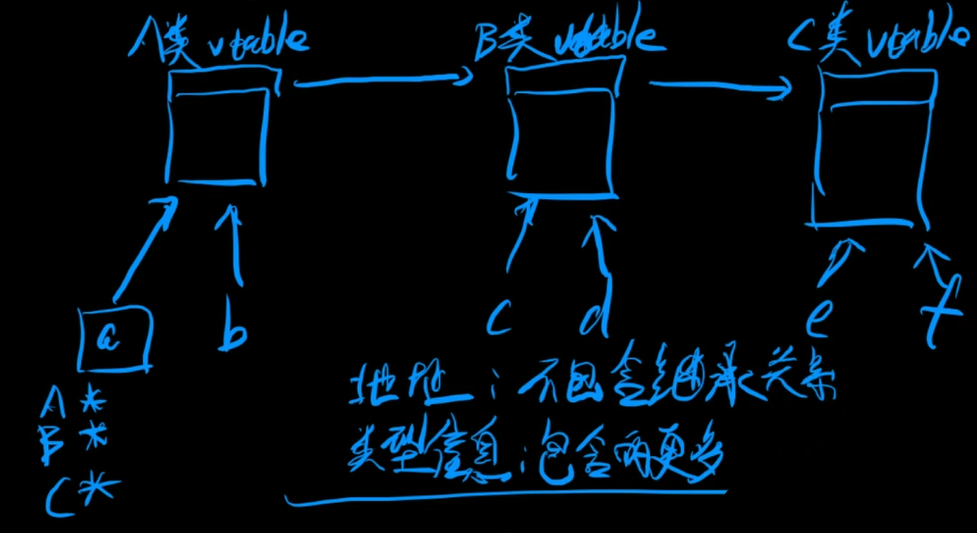多态 多态:简单的来说就是你跟你爸爸有相同的行为模式,但是具体的行为不一样就像是说你爸上班你也上班,但是工作内容不一样,你爸也会跑你也会跑但是你俩跑的姿势不一样 - 这个场景反馈的是父类和子类功能上的差别
普通的成员方法是跟着类走的
1 2 3 4 5 6 7 8 9 10 11 12 13 14 15 16 17 18 19 20 21 22 23 24 25 26 27 28 29 30 31 32 33 34 35 36 37 38 39 40 41 42 43 44 45 46 47 48 49 50 51 52 53 54 55 #include <iostream> using namespace std ;#define BEGINS(x) namespace x { #define ENDS(x) } BEGINS(test1) class Animal {public : void run () cout << "I don't know to run" << endl ; return ; } }; class Cat :public Animal {public : void run () cout << "I can run with fout legs" << endl ; return ; } }; int main () Cat a; Animal &b = a; Animal *c = &b; a.run(); b.run(); c->run(); return 0 ; } ENDS(test1) int main () test1::main(); return 0 ; }
虚函数
c++中的虚函数的作用主要是实现了多态的机制。关于多态,简而言之就是用父类的指针指向其子类的实例,然后通过父类的指针调用实际子类的成员函数。这种技术可以让父类的指针有”多种形态”,这是一种泛型技术。
如果调用非虚函数 ,则无论实际对象是什么类型,都执行基类的类型所定义的函数。
非虚函数总是在编译时根据调用该函数对象,引用或指针的类型而定。如果掉虚函数,则直到运行时才能正确调用那个函数,运行的虚函数是引用所绑定或指针所指向的对象所属类型定义的版本。虚函数必须是基类的非静态成员函数。虚函数的作用是实现动态联编,也就是在程序的运行阶段动态地选择合适的成员函数,在定义了虚函数后,可以在基类的派生类中对虚函数重新定义,在派生类中重新定义的函数应与虚函数具有相同的形参个数和形参类型。以实现统一的接口,不同定义过程。如果在派生类中没有对虚函数重新定义,则它继承其基类的虚函数。
虚函数(Virtual Function)是通过一张虚函数表(Virtual Table)来实现的。简称为V-Table。在这个表中,主是要一个类的虚函数的地址表,这张表解决了继承、覆盖的问题,保证其容真实反应实际的函数。这样,在有虚函数的类的实例中这个表被分配在了这个实例的内存中,所以,当我们用父类的指针来操作一个子类的时候,这张虚函数表就显得由为重要了,它就像一个地图一样,指明了实际所应该调用的函数。
在父类中如果某个成员方法是虚的,那么在子类中相同的函数自动变成虚的
构造函数是不能是虚构造函数的 为什么构造函数不能是虚函数呢?这里你需要知道一个概念,那就是虚函数表vtbl,每一个拥有虚成员函数的类都有一个指向虚函数表的指针。对象通过虚函数表里存储的虚函数地址来调用虚函数。
那虚函数表指针是什么时候初始化的呢?当然是构造函数。当我们通过new来创建一个对象的时候,第一步是申请需要的内存,第二步就是调用构造函数。试想,如果构造函数是虚函数,那必然需要通过vtbl来找到虚构造函数的入口地址,显然,我们申请的内存还没有做任何初始化,不可能有vtbl的。因此,构造函数不能是虚函数。
虚函数是跟着对象走的
1 2 3 4 5 6 7 8 9 10 11 12 13 14 15 16 17 18 19 20 21 22 23 24 25 26 27 28 29 30 31 32 33 34 35 36 37 38 39 40 41 42 43 44 45 46 47 48 49 50 51 52 #include <iostream> using namespace std ;#define BEGINS(x) namespace x { #define ENDS(x) } BEGINS(test2) class Animal {public : virtual void run () cout << "I don't know to run" << endl ; return ; } }; class Cat :public Animal {public : void run () override cout << "I can run with fout legs" << endl ; return ; } }; int main () Cat a; Animal &b = a; Animal *c = &b; a.run(); b.run(); c->run(); return 0 ; } ENDS(test2) int main () test2::main(); }
运行结果
1 2 3 I can run with fout legs I can run with fout legs I can run with fout legs
虚函数->对象-> 运行期(运行时候才知道功能)-代码实现 1 2 3 4 5 6 7 8 9 10 11 12 13 14 15 16 17 18 19 20 21 22 23 24 25 26 27 28 29 30 31 32 33 34 35 36 37 38 39 40 41 42 43 44 45 46 47 48 49 50 51 52 53 54 55 56 57 58 59 60 61 62 63 64 65 66 67 68 69 70 71 72 73 74 75 76 77 78 79 #include <iostream> using namespace std ;#define BEGINS(x) namespace x { #define ENDS(x) } BEGINS(test3) class Animal {public : virtual void run () cout << "I don't know to run" << endl ; return ; } virtual void foo () cout << "foo function" << endl ; return ; } }; class Cat :public Animal {public : void run () override cout << "I can run with fout legs" << endl ; return ; } }; class Human :public Animal {public : void run () override cout << "I can run with two legs" << endl ; return ; } }; class Bird :public Animal {public : void run () override cout << "I can fly" << endl ; return ; } }; int main () srand(time(0 )); Animal *arr[10 ]; for (int i = 0 ; i < 10 ; i++) { switch (rand() % 3 ) { case 0 : arr[i] = new Cat(); break ; case 1 : arr[i] = new Human(); break ; case 2 : arr[i] = new Bird(); break ; } } for (int i = 0 ; i < 10 ; i++) { arr[i]->run(); } return 0 ; } ENDS(test3) int main () test3::main(); return 0 ; }
一定当基类的函数变成虚函数(析构函数),那么所有的派生类的函数(析构函数)也会变成虚函数
虚析构-代码实现 1 2 3 4 5 6 7 8 9 10 11 12 13 14 15 16 17 18 19 20 21 22 23 24 25 26 27 28 29 30 31 32 33 34 35 36 37 38 39 40 41 42 43 44 45 46 47 48 49 50 51 52 53 54 55 56 57 58 59 60 61 62 63 64 65 66 67 68 69 70 71 72 73 74 75 76 77 78 79 80 81 82 83 84 85 86 87 88 89 90 91 92 93 94 95 96 97 98 99 100 101 102 #include <iostream> using namespace std ;#define BEGINS(x) namespace x { #define ENDS(x) } BEGINS(test4) class Animal {public : virtual void run () cout << "I don't know to run" << endl ; return ; } virtual ~Animal() { cout << "Animal destructor" << endl ; } }; class Cat :public Animal {public : void run () override cout << "I can run with fout legs" << endl ; return ; } ~Cat() { cout << "Cat destructor" << endl ; } }; class Human :public Animal {public : void run () override cout << "I can run with two legs" << endl ; return ; } ~Human() { cout << "Human destructor" << endl ; } }; class Bird :public Animal {public : void run () override cout << "I can fly" << endl ; return ; } ~Bird() { cout << "Bird destructor" << endl ; } }; int main () srand(time(0 )); Animal *p; switch (rand() % 3 ) { case 0 : p = new Cat(); break ; case 1 : p = new Human(); break ; case 2 : p = new Bird(); break ; } p->run(); delete p; return 0 ; } ENDS(test4) int main () test4::main(); return 0 ; }
纯虚函数
纯虚函数是在基类中声明的虚函数,它在基类中没有定义,但要求任何派生类都要定义自己的实现方法。在基类中实现纯虚函数的方法是在函数原型后加“=0” virtualvoid GetName() =0。在很多情况下,基类本身生成对象是不合情理的。例如,动物作为一个基类可以派生出老虎、孔雀等子类,但动物本身生成对象明显不合常理。为了解决上述问题,将函数定义为纯虚函数,则编译器要求在派生类中必须予以重写以实现多态性。同时含有纯虚拟函数的类称为抽象类,它不能生成对象。这样就很好地解决了上述两个问题。将函数定义为纯虚函数能够说明,该函数为后代类型提供了可以覆盖的接口,但是这个类中的函数绝不会调用。声明了纯虚函数的类是一个抽象类。所以,用户不能创建类的实例,只能创建它的派生类的实例。必须在继承类中重新声明函数(不要后面的=0)否则该派生类也不能实例化,而且它们在抽象类中往往没有定义。定义纯虚函数的目的在于,使派生类仅仅只是继承函数的接口。纯虚函数的意义,让所有的类对象(主要是派生类对象)都可以执行纯虚函数的动作,但类无法为纯虚函数提供一个合理的缺省实现。所以类纯虚函数的声明就是在告诉子类的设计者,“你必须提供一个纯虚函数的实现,但我不知道你会怎样实现它”。
1 2 3 4 5 6 7 8 9 10 11 12 13 14 15 16 17 18 19 20 21 22 23 24 25 26 27 28 29 30 31 32 33 34 35 36 37 38 39 40 #include <iostream> using namespace std ;#define BEGINS(x) namespace x { #define ENDS(x) } BEGINS(test5) class Animal {public : virtual void run () 0 ; }; class Cat :public Animal {public : void run () override cout << "I can run with four legs" << endl ; return ; } }; int main () Cat a; return 0 ; } ENDS(test5) int main () test5::main(); return 0 ; }
virtual 关键字
语义: 子类的这个方法可能会跟父类的有所不同
成员方法调用时:
virtual关键字的方法跟着【对象】
非virtual关键字的方法跟着【类】
限制:
不能用来修饰【类方法-static】
为什么虚函数可以跟着对象走?
虚函数表 虚函数表给类带来的改变 1 2 3 4 5 6 7 8 9 10 11 12 13 14 15 16 17 18 19 20 21 22 23 24 25 26 27 28 29 30 31 32 33 34 35 36 37 38 39 40 41 42 43 44 45 46 47 48 49 50 51 52 53 #include <iostream> using namespace std ;#define BEGINES(x) namespace x { #define ENDS(x) } BEGINES(test1) class Base {public : virtual ~Base(){} }; class A :public Base {public : int x; }; class B {public : int x; }; int main () cout << "sizeof(Base) = " << sizeof (Base) << endl ; cout << "sizeof(A) = " << sizeof (A) << endl ; cout << "sizeof(B) = " << sizeof (B) << endl ; return 0 ; } ENDS(test1) int main () test1::main(); return 0 ; }
虚函数重写方法内存管理 1 2 3 4 5 6 7 8 9 10 11 12 13 14 15 16 17 18 19 20 21 22 23 24 25 26 27 28 29 30 31 32 33 34 35 36 37 38 39 40 41 42 43 44 45 46 47 48 49 50 51 52 53 54 55 56 57 58 59 60 61 62 63 64 65 66 67 68 69 70 71 72 73 74 75 76 77 78 79 80 81 82 83 84 85 86 87 88 #include <iostream> using namespace std ;#define BEGINES(x) namespace x { #define ENDS(x) } BEGINES(test2) class Base {public : virtual void func1 () cout << "Base func1" << endl ; return ; } virtual void func2 () cout << "Base func2" << endl ; return ; } virtual void func3 () cout << "Base func3" << endl ; return ; } virtual ~Base(){} }; class A :public Base {public : void func2 () override cout << "A func2" << endl ; return ; } int x; }; class B :public : void func1 () override cout << "B func1" << endl ; return ; } void func3 () override cout << "B func3" << endl ; return ; } int x; }; int main () A a; B b; a.func1(); a.func2(); a.func3(); b.func1(); b.func2(); b.func3(); ((func **)(&a))[0 ][1 ](); swap(((func **)(&a))[0 ], ((func **)(&b))[0 ]); cout << "--------------------------" << endl ; ((func **)(&a))[0 ][0 ](); ((func **)(&a))[0 ][1 ](); ((func **)(&a))[0 ][2 ](); return 0 ; } ENDS(test2) int main () test2::main(); return 0 ; }
虚函数表-代码合集
1 2 3 4 5 6 7 8 9 10 11 12 13 14 15 16 17 18 19 20 21 22 23 24 25 26 27 28 29 30 31 32 33 34 35 36 37 38 39 40 41 42 43 44 45 46 47 48 49 50 51 52 53 54 55 56 57 58 59 60 61 62 63 64 65 66 67 68 69 70 71 72 73 74 75 76 77 78 79 80 81 82 83 84 85 86 87 88 89 90 91 92 93 94 95 96 97 98 99 100 101 102 103 104 105 106 107 108 109 110 111 112 113 114 115 116 117 118 119 120 121 122 123 124 125 126 127 128 129 130 131 132 133 134 135 136 137 138 139 140 141 142 143 144 145 146 147 148 149 150 151 152 153 154 155 156 157 158 159 160 161 162 163 164 165 166 167 168 169 170 171 172 #include <iostream> using namespace std ;#define BEGINES(x) namespace x { #define ENDS(x) } BEGINES(test1) class Base {public : virtual ~Base(){} }; class A :public Base {public : int x; }; class B {public : int x; }; int main () cout << "sizeof(Base) = " << sizeof (Base) << endl ; cout << "sizeof(A) = " << sizeof (A) << endl ; cout << "sizeof(B) = " << sizeof (B) << endl ; return 0 ; } ENDS(test1) BEGINES(test2) class Base {public : virtual void func1 () cout << "Base func1" << endl ; return ; } virtual void func2 () cout << "Base func2" << endl ; } virtual void func3 () cout << "Base func3" << endl ; return ; } virtual ~Base(){} }; class A :public Base {public : void func2 () override cout << "A func2" << endl ; return ; } int x; }; class B :public Base {public : void func1 () override cout << "B func1" << endl ; return ; } void func3 () override cout << "B func3" << endl ; return ; } int x; }; typedef void (*func) () int main () A a; B b; a.func1(); a.func2(); a.func3(); b.func1(); b.func2(); b.func3(); ((func **)(&a))[0 ][1 ](); swap(((func **)(&a))[0 ], ((func **)(&b))[0 ]); cout << "--------------------------" << endl ; ((func **)(&a))[0 ][0 ](); ((func **)(&a))[0 ][1 ](); ((func **)(&a))[0 ][2 ](); return 0 ; } ENDS(test2) BEGINES(test3) class Base {public : virtual void func (int x) cout << this << " : Class Base : " << x << endl ; return ; } virtual ~Base(){} }; class A :public Base {public : void func (int x) override cout << "this->x = " << this ->x << endl ; cout << this << " : Class A : " << x << endl ; return ; } int x; }; typedef void (*func) (void *, int x) int main () A a, b; a.x = 1333 ; b.x = 12345 ; a.func(123 ); ((func **)(&a))[0 ][0 ](&a, 123 ); ((func **)(&a))[0 ][0 ](&b, 123 ); return 0 ; } ENDS(test3) int main () test3::main(); return 0 ; }
多态下类型转换 (动态类型转型) 1 2 3 4 dynamic_cast <>() dynamic_cast 就是判断-1 位置到底是什么来判断当前类型是什么
1 2 3 4 5 6 7 8 9 10 11 12 13 14 15 16 17 18 19 20 21 22 23 24 25 26 27 28 29 30 31 32 33 34 35 36 37 38 39 40 41 42 43 44 45 46 47 48 49 50 51 52 53 54 55 56 57 58 59 60 61 #include <iostream> using namespace std ;#define BEGINS(x) namespace x { #define ENDS(x) } BEGINS(test1) class Base {public : virtual ~Base(){} }; class A :public Base {};class B :public Base {};class C :public Base {};int main () srand(time(0 )); Base *p; switch (rand() % 4 ) { case 0 : p = new A(); break ; case 1 : p = new B(); break ; case 2 : p = new C(); break ; case 3 : p = nullptr ; break ; } A a; if (p) ((void **)(p))[0 ] = ((void **)(&a))[0 ]; if (dynamic_cast <A*>(p) != nullptr ) { cout << "p pointer A class Object" << endl ; } else if (dynamic_cast <B *>(p) != nullptr ) { cout << "p pointer B class Object" << endl ; } else if (dynamic_cast <C *>(p) != nullptr ) { cout << "p pointer C class Object" << endl ; } else { cout << "p is nullptr" << endl ; } return 0 ; } ENDS(test1) int main () test1::main(); return 0 ; }
dynamic_cast他为什么要用虚函数表的-1位置类型信息去作为类型转换判断的依据?
为什么虚函数表的类型信息 要放在-1?
类型信息大小是不固定的,为什么放在上面因为取的时候方便
手动实现-queu、priority_queue 实现 queue (队列):
循环队列
自动扩容 (2倍扩容法)
插入、删除
查看队头
大小
实现 priority_queue (优先队列):默认大顶堆
自动扩容 (2倍扩容法)
插入、删除
查看队头
大小
自定义优先比较规则
1 2 3 4 5 6 7 8 9 10 11 12 13 14 15 16 17 18 19 20 21 22 23 24 25 26 27 28 29 30 31 32 33 34 35 36 37 38 39 40 41 42 43 44 45 46 47 48 49 50 51 52 53 54 55 56 57 58 59 60 61 62 63 64 65 66 67 68 69 70 71 72 73 74 75 76 77 78 79 80 81 82 83 84 85 86 87 88 89 90 91 92 93 94 95 96 97 98 99 100 101 102 103 104 105 106 107 108 109 110 111 112 113 114 115 116 117 118 119 120 121 122 123 124 125 126 127 128 129 130 131 132 133 134 135 136 137 138 139 140 141 142 143 144 145 146 147 148 149 150 151 152 153 154 155 156 157 158 159 160 161 162 163 164 165 166 167 168 169 170 171 172 173 174 175 176 177 178 179 180 181 182 183 184 185 186 187 188 189 190 191 192 193 194 195 196 197 198 199 200 201 202 203 204 205 206 207 208 209 210 211 212 213 214 215 216 217 218 219 220 221 222 223 224 225 226 227 228 229 230 231 232 233 234 235 236 237 238 239 240 241 242 243 244 245 246 247 248 249 250 251 252 253 254 255 256 257 258 259 260 261 262 263 264 265 266 267 268 269 270 271 #include <iostream> #include <string> #include <functional> #include <stdlib.h> using namespace std ;#define BEGINS(x) namespace x { #define ENDS(x) } class IQueue {public : virtual void push (int ) 0 ; virtual void pop () 0 ; virtual int top () 0 ; virtual bool empty () const 0 ; virtual int top () const 0 ; virtual int front () const 0 ; virtual int size () const 0 ; virtual ~IQueue() {} }; class queue :public IQueue {public : queue (const int n = 10 ) : data((int *)calloc (sizeof (int ), n)), head(0 ), tall(0 ),count(0 ), __size(n) { } void push (const int val) override if (count == __size) { expand(); } data[tall++] = val; tall %= __size; count += 1 ; return ; } void pop () override if (empty()) return ; head += 1 ; head %= __size; count -= 1 ; return ; } bool empty () const override return count == 0 ; } int front () const override return this ->empty() ? false : data[head]; } int size () const override return count; } void swap (queue &q) std ::swap(this ->data, q.data); std ::swap(this ->head, q.head); std ::swap(this ->tall, q.tall); std ::swap(this ->count, q.count); std ::swap(this ->__size, q.__size); return ; } ~queue () { if (data) delete [] data; return ; } private : int *data; int head, tall, count, __size; void expand () queue q (2 * __size) while (!empty()) { q.push(this ->top()); this ->pop(); } this ->swap(q); return ; } int top () override return this ->empty() ? false : data[head]; } int top () const override return this ->empty() ? false : data[head]; } friend ostream &operator <<(ostream &out, const queue &); }; class priority_queue :public IQueue {private : int *raw_data, *data; int count, __size; function<int (int , int )> cmp; void expand () priority_queue q (2 * __size, cmp) while (!empty()) { q.push(this ->top()); this ->pop(); } this ->swap(q); return ; } friend ostream &operator <<(ostream &out, const priority_queue &); public : priority_queue (int n = 10 , function<int (int , int )> cmp = less<int >()) : raw_data(new int [n]), data(raw_data - 1 ), count(0 ), __size(n), cmp(cmp) {} int top () const override return this ->empty() ? false : data[1 ]; } int top () override return this ->empty() ? false : data[1 ]; } void push (const int val) override if (count == __size) { expand(); } count += 1 ; data[count] = val; up_maintain(count); return ; } void pop () override if (empty()) return ; data[1 ] = data[count]; count -= 1 ; down_maintain(1 ); return ; } void up_maintain (int ind) if (ind == 1 ) return ; if (cmp(data[ind >> 1 ], data[ind])) { std ::swap(data[ind], data[ind >> 1 ]); up_maintain(ind >> 1 ); } return ; } void down_maintain (int ind) if ((ind << 1 ) > count) return ; int temp = ind; #define LIND(x) (x << 1) #define RIND(x) (x << 1 | 1) if (cmp(data[temp], data[LIND(ind)])) temp = LIND(ind); if (RIND(ind) <= count && cmp(data[temp], data[RIND(ind)])) temp = data[RIND(ind)]; if (temp == ind) return ; std ::swap(data[temp], data[ind]); down_maintain(temp); return ; } bool empty () const override return count == 0 ; } int front () const override return this ->empty() ? false : data[1 ]; } int size () const override return count; } void swap (priority_queue &q) std ::swap(this ->raw_data, q.raw_data); std ::swap(this ->data, q.data); std ::swap(this ->count, q.count); std ::swap(this ->__size, q.__size); return ; } ~priority_queue () { if (data) delete [] raw_data; return ; } }; ostream &operator <<(ostream &out, const queue &q) { out << "queue : " ; for (int i = 0 , j = q.head; i < q.count; i += 1 , j += 1 ) { j %= q.__size; out << q.data[i] << " " ; } cout << endl ; return out; } ostream &operator <<(ostream &out, const priority_queue &q) { out << "priority_queue : " ; for (int i = 0 ; i < q.count; i += 1 ) { out << q.raw_data[i] << " " ; } cout << endl ; return out; } bool cmp (int x, int y) return x > y; } int main () int op, val; queue q1; priority_queue q2; priority_queue q3 (1 , cmp) while (cin >> op) { switch (op) { case 0 : { cin >> val; q1.push(val); q2.push(val); q3.push(val); } break ; case 1 : { cout << " queue front : " << q1.front() << endl ; cout << " priority_less : " << q2.top() << endl ; cout << "priority_greate : " << q3.top() << endl ; q1.pop(); q2.pop(); q3.pop(); } break ; } cout << q1; cout << q2; cout << q3; } return 0 ; }
源码文件*.cpp 点我跳转:https://github.com/qzwl123/C-/tree/main/%E5%A4%9A%E6%80%81














